Want to learn how to whistle loud enough to be heard across a crowded room, or even a whole field? Whistling loud isn't just about blowing hard; it's a technique that requires practice and precision. This comprehensive guide will teach you the secrets to unleashing your inner whistle virtuoso. Whether you're aiming for attention-grabbing volume or simply want to improve your whistling skills, read on!
Understanding the Physics of a Loud Whistle
Before diving into techniques, let's understand the science. A loud whistle results from creating a strong, focused airflow that vibrates efficiently within your mouth cavity. Factors influencing volume include:
- Air Pressure: The harder you blow (within reason – avoid straining!), the louder the whistle.
- Tongue Placement: The precise shaping of your mouth and tongue determines the frequency and resonance of the sound.
- Mouth Shape: The size and shape of the opening of your mouth acts as a resonating chamber, affecting loudness and tone.
Mastering the Technique: Step-by-Step
Here's a breakdown of how to develop a powerful whistle, focusing on key steps:
1. Finding Your Whistle: Experiment with Mouth Shapes
There are several ways to form your mouth for whistling. Experiment with these:
- The "O" Shape: Pucker your lips as if you are about to kiss, creating a small, round opening.
- The "Peaked" Shape: Create a small opening by bringing your lips together, but with the top lip slightly more prominent.
- The "Slotted" Shape: Create a narrow, almost horizontal slit with your lips.
2. Tongue Positioning: The Key to Volume
This is crucial! Your tongue acts as a regulator of airflow and sound waves. Try these tongue positions:
- High and Forward: Place your tongue high in your mouth, just behind your top teeth, forming a channel.
- Curled at the Edges: Try curling the sides of your tongue slightly upwards to create a more focused airflow.
- Experiment with Different Tongue Positions: Slight adjustments can dramatically affect your sound.
3. Airflow Control: The Power Behind the Sound
Don't just blow; control your breath.
- Deep Breaths: Take deep, controlled breaths to maintain a consistent airflow.
- Consistent Pressure: Avoid blowing too hard or too softly; find a balance for optimal sound.
- Practice Makes Perfect: The more you practice, the better control you'll have over your airflow.
4. Practice Regularly
Consistency is key. Regular practice will strengthen your mouth muscles and refine your technique.
Troubleshooting Common Problems
- No Sound at All? Double-check your lip and tongue placement. Experiment with different positions.
- Weak Sound? Increase air pressure slightly, ensuring consistent airflow.
- Unpleasant Sound? Adjust your tongue and lip positioning.
Beyond the Basics: Tips for Extra Volume
- Resonance: Experiment with different mouth shapes to find the most resonant position for your voice.
- Posture: Good posture helps with breath control, allowing for a more powerful sound.
- Vocal Cords: Try humming slightly while whistling to add an interesting and powerful effect.
Conclusion
Learning to whistle loud takes practice, but with patience and the tips outlined above, you'll be amazed at the powerful whistle you can achieve. Remember to be mindful of your surroundings and avoid disturbing others with excessively loud whistling! Now go forth and whistle your heart out!

